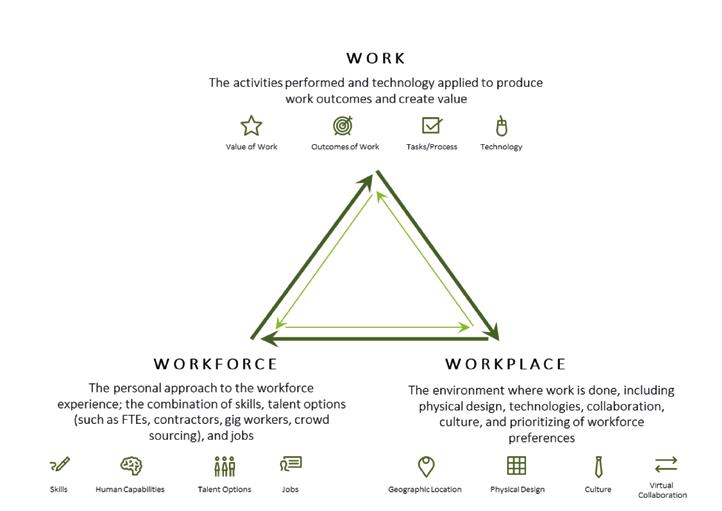
11 minute read
Virtual Assignments: Future-Proofing Your Mobility Programmes
The Genesis Of A New Type Of Assignment Technology has profoundly changed our personal and professional lives over time. We now routinely work in virtual teams with colleagues and clients who are in different physical locations. On this basis, many HR professionals had predicted that some international assignments would eventually be replaced by employees working remotely in cross-border roles, i.e. without physically moving, an arrangement commonly called “virtual assignment”. Whilst the concept is not entirely new, very few organisations have integrated virtual assignments in their Global Mobility frameworks, due to a variety of challenges that would need to be addressed.
The recent COVID-19 pandemic turned out to be a catalyst for change: most organisations had no choice but to repatriate their international assignees, put on hold all new assignments, and ask both international and domestic employees to work from home. Suddenly, remote employment had become a reality.
Despite the disastrous impact on people and businesses, the crisis provided an important “reality check” on how much work can be done remotely. It is not surprising, therefore, that the topic of virtual assignments gained popularity amongst Mobility professionals. But is it feasible to take an arrangement that was borne out of a crisis, and recognise it as an official assignment type? The answer is “maybe”, provided the implications and complexities are understood and addressed. Let’s look at some fundamental considerations.
Why Virtual Assignments? The pandemic, together with the associated lockdowns and travel restrictions, definitely played a key role in pushing Virtual Assignments higher on the agenda of Mobility professionals. But other factors provided the right context too. The digitalisation of many aspects of work made it possible for some roles to be performed remotely. At the same time, workforce demographics are changing, with a growing representation of a younger workforce that grew up in the digital age, and generally more tolerant of flexible working practices.
Virtual assignments also provide a potential alternative in situations where employees may be reluctant to move physically, due to personal or family considerations, which can be real barriers to mobility. This means that virtual assignments may allow organisations to secure the best talent, irrespective of their location and propensity to relocate. Some employers may one day also use virtual assignments to optimise human capital costs, by reducing the need for expensive expatriate packages and leveraging salary differentials across locations.
It appears, therefore, that the timing may be right: virtual assignments have the potential to meet the needs and expectations of both employers and employees, albeit in different ways. Technology tools that enable us to work remotely have already become mainstream in many organisations, and the pandemic forced us to learn quickly how to run a business with a geographically distributed workforce. It is unlikely that virtual assignments will fizzle out once the pandemic blows over. More likely, they will be increasingly recognised as a legitimate assignment type and formally integrated in mobility programmes.
Key Challenges Nevertheless, virtual assignments are fraught with challenges, which need to be understood and addressed in order to succeed. Here’s a few:
Feasibility, Eligibility And Cost For a start, it is important to define the eligibility criteria for virtual assignments, by identifying which jobs could be realistically performed remotely. In addition to the practical requirements of the role, it may be wise to consider other factors such as time zones, geographical scope of the role, the presence of a local subsidiary, access to IT support, and more.
It would be unwise to assume that a virtual assignment will always cost less than a traditional assignment, as this is often not the case. Therefore, it would be advisable to run some simulations to estimate the financial impact. Regulatory And Compliance Considerations One of the key considerations for virtual assignments is to determine which entity is the “employer of record” and who will be responsible for compliance obligations such as tax withholdings, payroll reporting, employer’s social contributions, and so on. If the organisation has a local subsidiary, this could be used to host and support the virtual assignee, but if the company has no legal presence in the country, the situation becomes slightly more complicated, since some countries allow such “employment without establishment”, whereas others don’t.
It is important to remember that the prevailing labour law will be that of the country where the virtual assignee is physically located. Hence the HR team managing these virtual assignees needs to ensure compliance in all applicable jurisdictions. This is an important point to remember, especially in the event of disputes, disciplinary procedures, separations, etc. It is also worth bearing in mind that in some countries there may be collective agreements applicable to specific industry sectors.
Local legislation will also dictate any minimum statutory benefits that need to be provided, such as medical, life, accident and disability. In locations where the headcount is low, these insurance plans may be expensive, due to lack of critical mass.
Lastly, there is the well-known issue of Permanent Establishment risk, which could be created when an employee is performing work in one country on behalf of an overseas entity. The details of what constitutes a Permanent Establishment are generally to be found in tax treaties, and there is no universal definition. Typically, such situations could give rise to Corporate Tax and/or VAT liabilities, which need to be taken into account.
Cultural Readiness Any organisation considering the introduction of any form of “remote employment” should carefully consider whether the organisation is culturally ready for it. The “cultural readiness” could be specific to a geographic region, or it could depend on the organisation, its leadership and the demographic profile of the workforce. In some cultures, both
leaders and employees find it culturally hard to accept the idea of not being physically present in the workplace with the rest of the team. Likewise, there are some organisations where leaders prefer a more traditional working culture and struggle to embrace the idea that a team member may be present only virtually. In addition, there could also be generational differences in the readiness to accept virtual employees.
Performance And Career Management In a virtual assignment scenario, it is important to ensure that the virtual assignees continue to feel a strong sense of affiliation and shared identity with the rest of the organisation, function, and team to which they belong. The quality, frequency and mode of communication should be just right, in order to preserve engagement and alignment without eroding productivity through unnecessary meetings. In addition, there should be a consistent and conducive company culture, where virtual assignees are accepted. Failure to achieve this may result in virtual assignees being disadvantaged during performance, salary, and career reviews, compared to peers who are physically closer to their leaders.
Working remotely from managers and colleagues will test the virtual assignees’ ability to self-motivate and work independently, especially if working from a location where there is no local company. In such situations, non-technical attributes such as planning, communication skills, adaptability and problem-solving skills would definitely help the virtual assignee’s performance and productivity. In fact, any analysis of the costs and benefits of virtual assignments would, ideally, also include an assessment of the potential impact on performance and productivity.
Infrastructure And Employee Support In situations where the virtual assignee is physically in a location without a local subsidiary, it is important to establish what infrastructure would be available to the employee and how support would be provided, if required.
If there is no local subsidiary, the employee may be expected to work from home, or from a shared office. This may raise some concerns regarding security and confidentiality. HR, IT and Finance Department support could be provided remotely for most situations, but time zone differences may introduce some delays that could impact productivity and morale. It is therefore a good idea to proactively ensure that the virtual assignees have a conducive working environment and are adequately supported.
Managing Virtual Assignees Having reviewed some of the key challenges, it may be useful to review some practical options for the operational management of virtual assignments. There is no “silver bullet” solution that works for every organisation, and it is important that each company designs a model that perfectly fits its objectives. Nevertheless, there are three broad approaches that could be adopted, with the necessary modifications, to manage a population of virtual assignees.
Employ The Virtual Assignees Through Local Subsidiaries If local subsidiaries exist in the location where the virtual assignees are based, it is almost natural to use these entities to employ and support them. This would be an easy and convenient approach. However, in companies with many virtual assignees this could become a rather messy and cumbersome model, since each entity may be hosting virtual assignees who are supporting other overseas entities, as well as perhaps receiving support from virtual assignees based overseas.
In this scenario, the potential exposure to Permanent Establishment risk is multiplied, and it is difficult to ensure that in each location there are the necessary skillsets to keep all these virtual assignees compliant. Such a decentralised model it is also likely to create duplication of effort and make it harder to aggregate data.
The model is also not very scalable, since the complexity will increase as virtual assignments are created in more locations. The model also relies on having subsidiaries in the right locations, and therefore does not always provide global coverage. It is also worth pointing out that if the virtual assignee goes on a real assignment (i.e. a physical relocation), the employing entity will change.
Employ The Virtual Assignees Through A Professional Employer Organisation (PEO) Under this arrangement, the PEO becomes the “Employer of Record” of the virtual assignee, which means that, legally speaking, the virtual assignee is employed locally by a third party. PEOs tend to have global coverage, which makes this model more scalable and not at all reliant on having local subsidiaries. From a client’s perspective, PEOs also provide some level of central coordination and aggregation of data. Arguably, PEO arrangements may be more suitable for virtual assignments of a finite duration, and perhaps less suitable for openended contracts.
Since the virtual assignee is employed by the PEO, the organisation will have slightly less control over the “employee experience” and will need to work a little harder to ensure that the virtual assignee doesn’t feel like a “contractor”. In this case too, if the virtual assignee physically relocates to a different location, the employing entity will change.
Employ The Virtual Assignee Through A Global Employment Company (GEC) Under a GEC arrangement, the virtual assignees would all have an employment contract with a legal entity (a Global Employment Company) fully owned by their organisation. Therefore, these virtual assignees will continue to be employed by the company, rather than by a third party, and will always have an employing entity hosting them, regardless of their physical location.
The GEC provides a central point of coordination as well as central consolidation of the necessary skills, experience and infrastructure. The GEC can host both virtual and traditional assignees, thereby providing even greater economies of scale. This also implies that if a virtual assignee becomes a “real” assignee by physically relocating, he/she can remain employed by the GEC, hence there will be no change of employing entity. Furthermore, by aggregating the headcount of virtual assignees in a single legal entity, it is easier to create the critical mass required for international insurance and retirement plans.
The GEC arrangement can also help to centralise and potentially mitigate Permanent Establishment exposure by having a single legal entity (rather than multiple entities) employing the assignees. The GEC would be responsible for support and compliance in the various locations where the virtual (and non-virtual) assignees are located.
Preparing For The Future Several companies are now taking the first steps to assess the feasibility of virtual assignments. The good news is that there are options, each with its own set of implications. Therefore, it essential to do some thorough homework to evaluate costs and benefits, before putting something in place. Specialist mobility consulting firms, such as ITX, are pioneering viable models to help organisations prepare for the future and to design solutions that are fit for purpose.
The next couple of years may well shape the future of Global Mobility, and the current pandemic is just the latest reminder of the importance of having the organisational agility to respond to the unexpected. In today’s uncertain and volatile world, it is highly likely that virtual assignments will continue to evolve, enter mainstream Mobility practices and become an absolute necessity for most organisations.
MARIO FERRARO Mario Ferraro is internationally recognised as a Thought Leader in the area of Global Mobility and International HR. During his career he helped some of the world’s best organisations to design and implement effective Global Mobility solutions. His experience spans 3 decades and includes leadership roles with some of the world’s leading consulting firms, as well as global roles in International HR and Mobility. E: mferraro@itx-sg.com.

VINCENT HENNEQUIN Vincent Hennequin assists international organisations achieve simplification and cost-effectiveness of their expatriation programmes, in full compliance with international regulations. He works with clients to explore their organisational needs and identify suitable interventions ranging from bespoke studies to full operational solutions. Vincent’s experience includes people development and coaching within multinational companies in different industries and geographies, including the Nordic and Baltic Countries, Russia, Germany and France. E: vhennequin@itx-ge.com.











